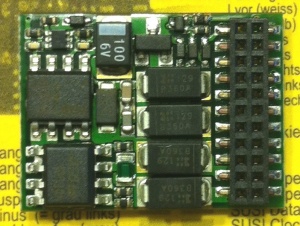DCC Ready
Summary: Some locomotive packages seen in the hobby shop display a badge proclaiming "DCC Ready." It indicates the modeller may install an NMRA DCC decoder later, without difficulty.
What Does DCC Ready Mean?
DCC Ready can mean a number of things. One primary feature is a motor isolated from the frame, making it easier to wire when installing a decoder.[1]
DCC Ready
A simple installation which will not require a lot of skill or special tools. Installing a multifunction decoder should not be difficult, although some older models may be more challenging.
There may be a light board that requires modification (by breaking the connections to the motor) and some soldering of wires to install a decoder.
Some decoders replace the light board. Often a drop – in type is available which completely replaces the OE light board of that specific model. With a screwdriver and a few minutes, conversion is easily accomplished.
Or a socket is provided, used with a matching connector on a suitable decoder. Often no soldering is required, just remove a shorting plug from the NMRA Connector and insert the multifunction decoder's plug to complete the installation. [2]
See the article on the various connectors used, both current and proposed.
Plug and Play
The multifunction decoder can be installed with a minimum of work. It usually just plugs into a connector and is ready to play.
There are a number of connectors in use, so verify what is needed first. Many manufactures today come with a 21 pin interface.
DCC Capable
It is not impossible to convert this locomotive to DCC, but it will take some time and effort to do so. Just about any locomotive can be considered DCC capable. The only real issue is the size of the decoder.
DCC Equipped
Usually indicates the model comes with an OEM DCC multifunction decoder installed at the factory. The multifunction decoder is often a basic generic version. It may be sound equipped as well. Keep in mind that OEM multifunction decoders are often stripped down versions with limited feature sets. The CVs available may not be equivalent to the retail version of the decoder.
Some multifunction decoders allow firmware upgrades, but OEM versions may impose limits on making changes. The locomotive manufacturer may offer software upgrades which are specific to their product's decoder, and will not work with other decoders. The decoder may have to be returned for upgrades. Aftermarket versions tend to more flexible.
Some manufacturers use an OEM multifunction decoder from a well-known supplier with exclusive features, such as lighting effects and custom sounds. The only way to get a decoder like this is to buy it installed in a locomotive. The OEM will not sell them and may provide limited support, referring you to the manufacturer of the locomotive. Some manufacturers have decoders specific to their product, and may offer them as upgrades.
Terms
- OEM Decoder: A multifunction decoder supplied exclusively to manufacturers for inclusion in their product. Often a cost reduced version with limited feature set and custom firmware.
- An OEM decoder may be an older version/model which is no longer offered at retail.
- Retail Decoder: A full featured multifunction decoder manufactured and packaged for retail sale.
Turnout - DCC Compatible
This often applies to turnouts or track switches meaning it is not difficult to adapt this piece of trackwork to DCC. See the page on turnouts for more details.
- ↑ Check the wiring to make sure that the motor is indeed isolated from the chassis.
- ↑ Not all multifunction decoders are available with matching NMRA 8 or 6 pin connectors, ask your dealer. The NMRA is discouraging their use, many new locomotives will have other interfaces
